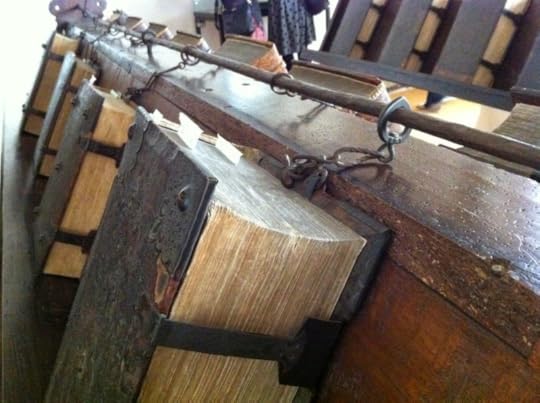The History and Impact of Chained Libraries
A chained library is a special type of library where books are chained to the shelves in order to prevent theft and ensure that the books remain in the library. They’ve been around for centuries, and the impact of these libraries is still being felt today. However, few people realise chained libraries were a real thing.
Chained libraries are often used as a source of mystery and danger in books and films as they’re a great way to add tension or suspense to a narrative. For example, one of the most iconic chained libraries is the Restricted Section of the Hogwarts library in the Harry Potter and the Philosopher’s Stone. This area of the library is filled with books that are chained to the shelves, and the students must search for the one book that they need to complete their quest. The library is guarded by a series of magical creatures, making it a dangerous and exciting place to explore.
A chained library also features in the movie The Cabin in the Woods. It contains a vast number of books that are chained to the shelves, and the characters must figure out how to unlock them in order to gain access to the knowledge that they contain. And, of course, in the season six finale of Game of Thrones, Samwell Tarly is granted access to the Citadel Library where many of the books are chained.
 The history of chained libraries
The history of chained librariesThe history of chained libraries dates back to the medieval era, when books were very expensive and hard to come by. One of the earliest chained libraries was built in 16th century England. It was established by Richard de Bury, the Bishop of Durham, and contained over 400 books.
Chained libraries worked by chaining books to the shelves with metal chains attached to the book’s spine. This ensured that the books remained in the library while still allowing readers to access the book’s contents. However, the process of chaining books was time consuming, as each book had to be individually chained to the shelves. It was also expensive as the metal chains had to be purchased and replaced regularly.
It was a popular system during the medieval era and was used in libraries all across Europe. Libraries were able to maintain their collections while ensuring that their patrons had access to the books they needed. They system eventually spread to other parts of the world, but over time the system of chaining books was eventually replaced by other methods such as locking books in cabinets or using bookplates.
The impact of chained libraries on book preservation has been mixed. On one hand, chained libraries have ensured that books remain in the library and are accessible to readers. On the other hand, the metal chains can cause damage to the book’s spine, which can lead to the book becoming damaged over time. Additionally, the metal chains can also cause discoloration of the book’s binding, as the metal can react with the paper and cause discoloration.
Despite this, chained libraries have been an important part of library history and have had a lasting impact on libraries around the world. In order to mitigate the impact of chained libraries on book preservation, libraries developed newer and more modern methods of book security.
Where can you see a chained library?There are numerous examples of chained libraries that still exist. For example:
Basilica of St. John, Oleśnica, Poland Bolton School, Bolton, Lancashire, England Chelsea Old Church, London, England Chetham's Library, Manchester, England houses the chained parish library of Gorton Church of All Saints, Wrington, Somerset, England Church of St John the Baptist, Glastonbury, England Francis Trigge Chained Library, Grantham, England Hereford Cathedral Library, Hereford, England Malatestiana Library, Cesena, Italy Royal Grammar School, Guildford, England St Peter's Church, Wootton Wawen, Warwickshire, England St Walburga's Church, Zutphen, The Netherlands Trinity Hall, Cambridge, England Wimborne Minster, England Wells Cathedral, Somerset, England(Source: Wikipedia)
 Preserving history
Preserving historyOnly five chained libraries remain intact, i.e., complete with their original furniture, books, and chains. However, according to Wikipedia there is some interest in reconstructing chained libraries. Wikipedia states that the library in the Church of Saint Walpurgis in the Netherlands and the Malatestiana Library in Cesena in Italy have undergone extensive restoration.
The library housed in St. Walburgis church in the town of Zutphen in the Netherlands dates back to the 16th century. Throughout the ages it has remained virtually unchanged and the ancient books are still chained to a wooden desk.
Likewise, the Hereford library is also open to the public. The oldest book in this library is Hereford Gospels. Written in the eighth century, the Hereford Gospels is one of 229 books located in the library.
Visiting these amazing archivesChained libraries have been an important part of library history and have had a lasting impact on libraries around the world. If you’ve ever visited one of these amazing archives, share you experience and post a pic in the comment section below!
S.C. Farrow Blog
As an Australian literary author and passionate advocate for the craft of creative writing, I delve int Welcome to my corner of the literary world, where words weave tales of creativity and resilience.
As an Australian literary author and passionate advocate for the craft of creative writing, I delve into the intricacies of storytelling, exploring both its joys and challenges. Join me as I navigate the nuanced landscapes of fiction, sharing insights into crafting compelling narratives and grappling with the profound journeys of characters.
From personal musings on the writer's life to the occasional guest post offering diverse perspectives, this blog is a sanctuary for writers and readers alike, celebrating the art and artistry of storytelling.
https://scfarrow.com/creative-writing... ...more
- S.C. Farrow's profile
- 15 followers



